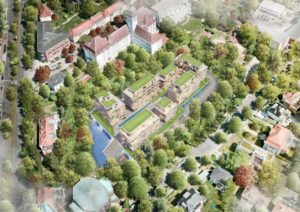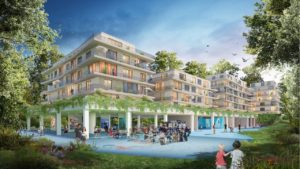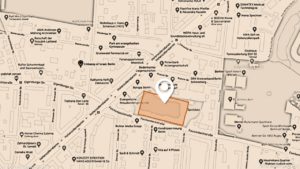Dass Wohnräume in Berliner Innenstadtlagen ein knappes Gut sind, ist keine neue Nachricht. Neu hingegen ist der Ansatz, den das in Berlin ansässige Architekturbüro Deluse Architects verfolgt. Dieses schlägt den Bau einer Wohnanlage auf Pfählen vor, die über einem Regenrückhaltebecken errichtet werden soll.
Überbauung des Regenrückhaltebeckens an der Forckenbeckstraße geplant
Konkrete Planungen hierfür gibt es für das an der Forckenbeckstraße (Ecke Hohenzollerndamm) befindliche Regenrückhaltebecken, welches offiziell als Grünfläche des Bezirks Charlottenburg-Wilmersdorf gilt.
Gemeinsam mit der landeseigenen Wohnungsbaugesellschaft DEGEWO will das Büro insgesamt sieben Häuser auf einem Plateau über dem Wasser errichten und damit 200 neue und bezahlbare Wohnungen schaffen. Das Projektvorhaben wurde bereits in der jüngsten Sitzung des Bauausschusses Charlottenburg-Wilmersdorf vorgestellt und intensiv diskutiert.
Gemeinsames Projekt von Deluse Architects und Degewo
Die neuen Gebäude sollen, so das Konzept von Architekt Peter Deluse, auf Pfählen von 4,50 Metern Höhe errichtet werden. Somit ist sichergestellt, dass die Häuser über dem maximal erreichbaren Wasserstand im Regenrückhaltebecken (bei maximalem Niederschlag) errichtet werden. Wenn das Becken nicht oder nur wenig mit Wasser gefüllt ist, könnten die Bewohner des Neubaus die Fläche in ihrer Freizeit nutzen.
Die Hälfte der Ein- bis Vier-Zimmer-Wohnungen soll für 6,50 Euro pro Quadratmeter vermietet werden, die andere Hälfte für etwa 11 Euro. Im Vergleich zum Mietniveau in dieser äußerst beliebten Wohngegend am Rande des Grunewalds wäre das ein besonderer Gewinn für den umliegenden Kiez und ein zusätzliches Angebot bezahlbarer Wohnungen.
200 neue MietWohnungen sollen entstehen
Die Häuser sollen bis zu sechs Geschosse umfassen und an den Rändern des Plateaus so verteilt werden, dass in ihrer Mitte Platz für eine kleine Straße wäre. Die DEGEWO will im Zuge des Neubaus gleichzeitig die Qualität des Rückhaltebeckens verbessern, welches im Sommer häufig faulig riecht, aufgrund von Rückständen im Wasser. Das Unternehmen plant, gemeinsam mit den Berliner Wasserbetrieben eine Art Kläranlage einzubauen.
Vorbehalte gegen das innovative Projekt gibt es erstaunlicherweise aus der Fraktion der Grünen, die die Fläche weiter als Grünfläche erhalten wollen. Im Bauausschuss des Bezirks ist die Partei allerdings die einzige Fraktion, die gegen das Bauvorhaben votiert. Auch Baustadtrat Oliver Schruoffeneger (Grüne) hat signalisiert, das Projekt bei einer Mehrheit im Bauausschuss nicht zu bekämpfen, sondern objektiv zu begleiten.
Mehrheit im Bauausschuss für das Projekt
Voraussetzung für eine Umsetzung des Projekts ist die Umwidmung der Fläche in Bauland und die Aufstellung eines Bebauungsplans. Diese Aufgabe liegt derzeit beim Bezirksamt. Ziel der beteiligten Fraktionen ist die zeitnahe Umsetzung des Vorhabens, das ist nach der jüngsten Diskussion um das Projekt deutlich geworden.
Sollte das Vorhaben realisiert werden, wäre es sicher ein Projekt mit Modellcharakter, da es in Berlin noch weitere solcher Flächen gibt, die für eine solche Überbauung infrage kämen. Wir werden das Projekt weiterhin aufmerksam begleiten.
In der Wilmersdorfer Forckenbeckstraße gibt es noch weitere Bauvorhaben, die Ihr hier einsehen könnt.
Wer mehr über das Thema ökologisches Bauen herausfinden möchte, kann dies in Petra Liedls Buch “Gesundes Bauen und Wohnen – Baubiologie für Bauherren und Architekten” nachlesen.
That living space in Berlin’s inner-city locations is a scarce commodity is not new news. What is new, however, is the approach taken by Berlin-based Deluse Architects. This proposes the construction of a residential complex on piles, to be built over a rainwater retention basin.
PLANS TO BUILD OVER THE RAINWATER RETENTION BASIN ON FORCKENBECKSTRASSE
Concrete plans for this exist for the rainwater retention basin located on Forckenbeckstrasse (corner of Hohenzollerndamm), which is officially considered a green area of the Charlottenburg-Wilmersdorf district.
Together with the state-owned housing company DEGEWO, the office plans to build a total of seven houses on a plateau above the water, creating 200 new and affordable apartments. The project plan was already presented and intensively discussed at the recent meeting of the Charlottenburg-Wilmersdorf building committee (“Bauausschuss”).
JOINT PROJECT BY DELUSE ARCHITECTS AND DEGEWO
According to architect Peter Deluse’s concept, the new buildings will be built on piles 4.50 meters high. This ensures that the houses will be built above the maximum achievable water level in the rainwater retention basin (at maximum precipitation). When the basin is not filled with water, or only slightly, the residents of the new building could use the area in their leisure time.
Half of the one- to four-room apartments are to be rented for 6.50 euros per square meter, the other half for about 11 euros. Compared to the rent levels in this extremely popular residential area on the edge of the Grunewald, this would be a particular benefit for the surrounding neighborhood and an additional supply of affordable apartments.
200 NEW RENTAL APARTMENTS TO BE BUILT
The houses are to have up to six stories and be distributed along the edges of the plateau in such a way that there would be space for a small street in their center. In the course of the new construction, DEGEWO simultaneously wants to improve the quality of the retention basin, which often smells foul in summer due to residues in the water. The company plans to work with Berliner Wasserbetriebe to install a type of sewage treatment plant.
Surprisingly, there are reservations about the innovative project from the Green Party, which wants to keep the area as a green space. In the district’s building committee, however, the party is the only faction to vote against the construction project. Oliver Schruoffeneger (Green Party), a city councilor for construction, has also signaled that he will not oppose the project if it receives a majority in the building committee, but will support it objectively.
MAJORITY IN THE BUILDING COMMITTEE FOR THE PROJECT
The prerequisite for implementation of the project is the redesignation of the area as building land and the preparation of a development plan. This task currently lies with the district office. The goal of the factions involved is the prompt implementation of the project, which has become clear after the recent discussion about the project.
Should the project be realized, it would certainly be a project with a model character, since there are other such areas in Berlin that could be considered for such a superstructure. We will continue to follow the project closely.




Martin Neustadt April 17, 2021
Guten Tag, wie kann man sich denn auf eine der Wohungen bewerben? Viele Grüße
Ihr Martin Neustadt